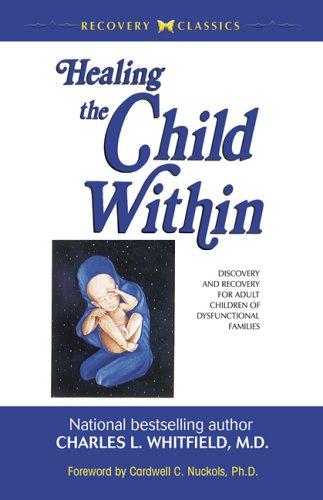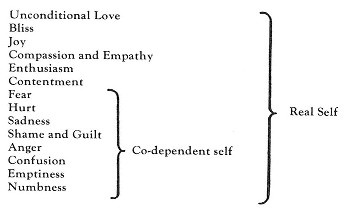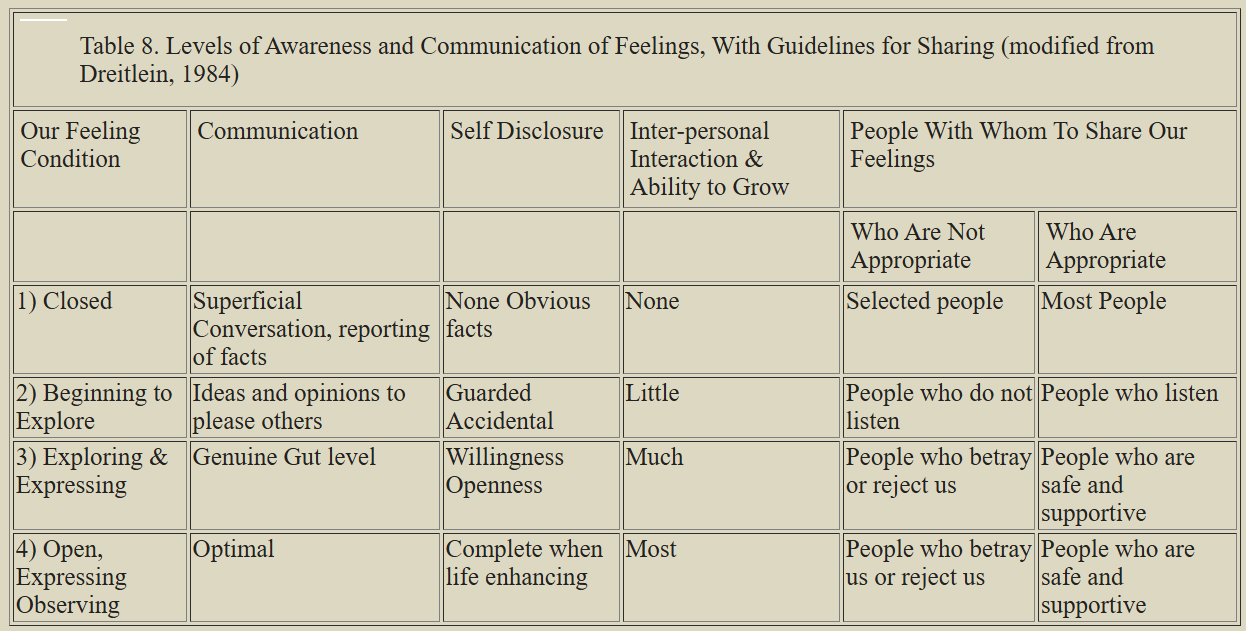Healing the Child Within:
Discovery and Recovery for Adult Children of Dysfunctional Families

Chapter 10
Identifying and Experiencing Our Feelings
Becoming aware of our feelings and constructively dealing with them is crucial in the process of healing our Child Within.
People who grew up in troubled or dysfunctional families don't tend to get their needs met. Not getting our needs met hurts. We feel the painful feelings. Since the parents and other members of such families tend themselves to be unable to listen to us, to support us, and to nurture, accept, and respect us, we often have no one with whom we can share our feelings. The emotional pain hurts so much that we defend against them by the various unhealthy ego defenses described in Chapter 8, thus shutting the feelings out, away from our awareness. Doing so allows us to survive, although at a price. We become progressively numb. Out of touch. False. Co-dependent.
When we are thus not our Real Self, we do not grow mentally, emotionally, and spiritually. Not only do we feel stifled and unalive, but we also often feel frustrated and confused. We are in a victim stance. We are unaware of our total self, and we feel as though others, "the system," and the world are "doing it to us," i.e., we are their victim, at their mercy.
A way out of this victim stance and its suffering is to begin to identify and to experience our feelings. An effective way to facilitate knowing and experiencing our feelings is to talk about them with safe and supportive people.
Bill was 36-years-old, successful at work but not in the intimate relationship he wanted. In group therapy one day he said, ''I hated my feelings and being always asked to talk about them here. After two years in this group, I'm beginning to see how important they are. And I'm even beginning to enjoy them, even though some are painful. Basically, I feel more alive when I feel my feelings."
There is no need for us to know everything about our feelings. All we need to know is that feelings are important, that we each have all of them, and that it is healthy to begin to know them and to talk about them. Our feelings can be our friends. Properly handled, they will not betray us; we will not lose control, be overwhelmed or engulfed as we fear.
Our feelings are the way we perceive ourselves. They are our reaction to the world around us, the way we sense being alive (Viscott, 1976). Without awareness of our feelings, we have no real awareness of life. They summarize our experience and tell us if it feels good or bad. Feelings are our most helpful link in our relationship with ourselves, others and the world around us.
The Spectrum of Feelings
We have two basic kinds of feelings or emotions joyful and painful. Joyful feelings make us feel a sense of strength, well being and completion. Painful feelings interfere with our sense of well being, use up our energy and can leave us feeling drained, empty and alone. Yet even though they may be painful, they are telling us something, a message to ourself that something important may be happening, something that may need our attention.
Being aware of our feelings, and feeling them in a natural flow, as they occur spontaneously from minute to minute, day to day, gives us several advantages. Our feelings both warn us and assure us. They act as indicators or gauges of how we are doing at the moment and over a stretch of time. They give us a sense of mastery and aliveness.
Our Real Self feels both joy and pain. And it expresses and shares them with appropriate others. However, our false or co-dependent self tends to push us to feel mostly painful feelings and to withhold and not share them.
For simplicity, we can describe these joyful and painful feelings across a spectrum, starting with the most joyous, going through the most painful, and ending with confusion and numbness, as follows:

Viewing our feelings in this way, we see that our Real and True Self, our Child Within, is empowered with a wider range of possibilities than we might have believed. The maintenance and growth of our Child Within is associated with what psychotherapists and counselors call a ''strong ego," i.e., a flexible and creative ego that can "roll with the punches" of life. By contrast, the co-dependent self tends to be more limited, responding to mostly painful feelings or no feeling at all, i.e., numbness. Our co-dependent self tends to be associated with a "weak ego," i.e., a less flexible, self-centered (negative or egocentric) and more rigid one. To cover up the pain we use relatively unhealthy ego defenses which give us fewer possibilities and choices in our lives.
Levels of Awareness About Feelings
In order to survive, a person who grew up in or is presently living in a troubled environment tends to be limited to the feeling armamentarium of the co-dependent self. As we begin to explore and become more aware of our feelings, we discover that we can have different levels of awareness about them.
Closed About Our Feelings
When we cannot feel a feeling, we are closed in our ability to use it (Table 8). At that stage not only do we not know the feeling, but also we are unable to communicate the condition of our True Self. While we may be talking superficially or even reporting facts, our interpersonal interaction and our ability to experience life and to grow is very low. We can call this stage of growing and sharing our feelings Level One.
Beginning to Explore
At Level Two we can begin to explore our feelings. We may be guarded in sharing our newly found feelings, and they may come out in conversation disguised as ideas and opinions rather than actual feelings. At this level interactions with others and our ability to experience life and grow remains low, but it is greater than where we were in Level One. While most people have feelings and would often like to express them, most of them do not do so and thus live their lives in a low awareness and sharing of their feelings, limited to functioning in Levels One and Two. This limited use of feelings is what the co-dependent self is accustomed to.
Exploring and Experiencing
As we begin to know our True Self, we begin to explore and to experience our feelings at a deeper or "gut" level. Here we are able to tell others as feelings come up for us how we really feel. By doing so we can have much interpersonal interaction with people who are important to us and can experience our life more. We thereby grow mentally, emotionally and spiritually. When we reach this Third Level of our feelings, we are better able to experience intimacy with another.
Sharing Our Feelings
However, sharing our feelings with another is like a two-edged sword. First, we may share them with someone who does not want to listen. They may themselves be functioning at Levels One or Two and be incapable of listening. Or they may appear to be listening, but are preoccupied with their own agenda, which is entirely different from ours. Or even more painful results could happen. We could share with someone who is not safe and supportive, and we might be rejected for sharing and we may even be betrayed. The difficulty in sharing feelings is shown in the following.

Ken was a 34-year-old successful salesman who grew up in a family where his father and brother were actively alcoholic and his mother was co-alcoholic. In his therapy group he spoke of how he had recently set limits on his brother's attending a birthday celebration at Ken's house by asking his brother not to drink or use drugs at the occasion. When asked about how he felt about his brother's potentially disrupting the party since that was his pattern in the past, he told the group that he felt "fine" about it. The group members asked him how he really felt and again he said, "Well, fine. But I told you this today to get your feedback." The group continued to ask him how he really felt. Gradually, he realized that he had been blocking and suppressing feeling fear, anger, frustration and confusion, and he told that to the group.
Ken took advantage of being in a therapy group by using them as a mirror, asking them for their feedback. He had been in the group for three months at the time and was beginning to trust the group as being a safe and supportive place and a resource in which he could air his concerns and confusions. He used the group to help him to discover an important part of his True Self.
When we share our feelings, it is most appropriate to do so with safe and supportive people. Early in recovery people who grew up in troubled or dysfunctional families may want so much to share that they get rejected, betrayed or otherwise get into trouble by telling others, indiscriminately, about their feelings. They may find it difficult to learn that it is not appropriate to share feelings with everyone.
How do we decide who is safe and who is not? One way is by the technique of share-check-share (Gravitz, Bowden, 1985). When we have a feeling that we want to share, but perhaps aren't sure of who is safe and who is not, we can share just a bit of our feelings with selected people. Then we check their response. If they don't seem to listen or if they try to judge us or if they immediately try to give us advice, we may not wish to share any more feelings with them. If they try to invalidate our feelings, or if they reject us and certainly if they betray us by talking about us, and especially our confidences then they are probably not "safe" to continue sharing with. However, if they listen, are supportive and do not react with the above responses, then it may be safe to continue sharing with them. Further clues for "safe" people are those who make eye contact with us, tend to appear sympathetic and don't try to rush in and change our feelings. Over the long term someone who is safe will be consistent in listening and supporting and will not betray or reject us.
